|
[Front Page] [Features] [Departments] [Society Home] [Subscribe]

Weeds - The Silent Invaders
Greg Calvert
This article was presented to the Society for Growing Australian Plants' Queensland Region Conference, Townsville, 28 June-5 July, 1998. Although concerned primarily with the situation in Queensland, readers in other areas will recognise some depressingly similar situations.
Introduction
There are, in the world, more than 2,400 plants which are considered weeds, depending on where you are. Australia has approximately 1,500 environmental weeds, while Queensland suffers under the burden of 1,165 species of introduced plants, many of which have become weeds. Weeds affect everybody, including graziers, national parks staff, land owners, agriculturists and users of waterways. In the United States, weeds have cost their economy 97 billion dollars and are expected to cost a further 134 billion. In 1997, weeds cost the Australian economy 500 million dollars, in terms of lost productivity and cost of removal. This is a purely economical viewpoint. If you tried to calculate the damage to the environment caused by all these weeds, the estimate must run into the billions of dollars to rectify the situation. In Australia, the cost of weed control gets passed on to the consumer, so we pay for weed control everyday with our meat and vegetables.
So what are we doing about it?
In this state, the Rural Lands Protection Board oversees the control of weeds and they have a classification system which I need to explain to you before we go any further. Weeds may be "declared" under legislation as a weed or not. If they are "declared" a weed, they may fall into one of five categories:
- P1: Introduction into Queensland is prohibited (fine of $3000)
- P2: These plants must be destroyed
- P3: Numbers or distribution of these plants are to be reduced
- P4: These plants are to be prevented from spreading
- P5: These plants only need to be controlled on government owned land.
If you have a declared weed growing on your property, you are legally required to deal with it appropriately. No declared weeds are allowed to be sold. Local governments (councils) have the right under the Local Government Act to declare weeds in their area, although unfortunately, few shires have ever exercised this right. Different shires have different weed problems, so, in some cases, a weed is declared in one shire and not in another, or a plant may fall into several different categories depending on which shire they are in. Of course, this is all very controversial, and the main reason for this is that people's definition of a weed varies considerably depending on their perspective. In my humble dictionary, a weed is defined as being: "a plant considered troublesome or useless, esp. one growing abundantly in cultivated ground". To me, this definition doesn't work well with environmental weeds.
|
| "....environmental weeds are almost always outside their natural distribution. By moving plants around, you leave behind the pests and diseases which keep them under control in their own environment. " |
|
"Environment Australia" defines an environmental weed as being those that invade and thrive in environments in which they do not naturally occur. I prefer to include my own addition, being that "an environmental weed, by its very nature, interferes with the natural processes of the environment". In other words, plants capable of smothering and choking the bush, and suppressing natural regrowth. It is important to stress that environmental weeds are almost always outside their natural distribution. By moving plants around, you leave behind the pests and diseases which keep them under control in their own environment. This could also be said of pest animals as well. Queensland has 58 plants which are declared and there are dozens more which are totally prohibited from entering the state in case they cause massive environmental destruction.
Water Weeds
For many people, the word "weed" conjures up thoughts of grasses or herbs. To get us off that track, I want to start talking about water weeds. In the Townsville area, we have 3 floating plants which are declared weeds.
Water Hyacinth has pretty blue flowers which is why it was introduced for fish ponds and aquariums. This plant quickly found its way into local waterways and spread rapidly. It can block entire river systems completely, shading out the river and starving the water of oxygen. All the native water plants die in the deep shade and fish can die from suffocation. Although some people use it for mulch, such harvesting never makes much of a dent. Due to active transpiration of water through the leaves, they act like floating water pumps and contribute greatly to evaporation of water from dams. The Egyptian government have launched a campaign against Hyacinth since they found that they are a large percentage of water every year from their giant Aswan Dam from Hyacinth. Large floods often clear much of the hyacinth out of Ross River, however, enough always remains trapped to recolonise the rivers. A number of years ago, a weevil was introduced which has had the effect of preventing this terrible weed from forming anything larger than small colonies.
The Hyacinth shares our local waterways with another weed, Salvinia (Salvinia molesta, so named because it molests and destroys waterways). Salvinia is actually a floating fern and, like hyacinth, tends to reproduce vegetatively rather than sexually. It grows extremely fast, doubling in just 3 days. Once, it formed great mats across Ross River, so thick I have seen people walking across the river on the thick mats. Nothing can live beneath such a smothering mat. Fortunately, this weed too has been reined in by the introduction of a particular weevil and it now exists in only small pockets.
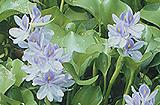 |
Top: A native of Central and South America, Water Hyacinth (Eichhornia crassipes) spreads rapidly and can completely cover watercourses.
Bottom: Water Lettuce (Pistia stratiotes, has caused massive problems in many parts of the world.
Select the thumbnail image or highlighted name for a higher resolution image (53k and 29k).
Photos: Greg Calvert
| 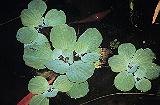 |
A third invasive water weed is the Water Lettuce, Pistia stratiotes. In the Panama Canal in central America, huge mats of water lettuce have prevented the passage of great ocean going tankers. It is listed amongst the three worst water weeds in the world and is responsible for choking out waterways, killing off aquatic wildlife and increasing the extent of flooding. For some reason, it has not been so prolific in Queensland. Some say it is due to competition from Hyacinth, however, the reduction in hyacinth has not seen an explosion in water lettuce. At a local zoo, a well meaning tourist thought this attractive plant would brighten up their waterhole. It has since cost that company thousands of dollars in trying to eradicate the menace. It appears that many people find the lettuce-shape of this plant attractive and appealing and I recently saw some floating in a display in a rainforest theme conservation store in Cairns. Since Pistia is a declared weed, any such cultivation or sale of the plant is illegal.
Aquatic Grasses
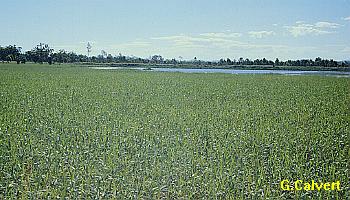 
Along the edges of our weed infested rivers, once beautiful riverbanks are now choked to death under a smothering blanket of rank feral grasses. The worst in the Townsville area is the South American Para Grass (Brachiaria mutica). This grass was introduced for the cattle industry as fodder. This grass, especially when it isn't grazed, forms a tall, thick blanket over the land and floats out over the water. It sends out long runners that send down roots along its length, making removal extremely difficult. It is the single biggest threat to our local wetlands and the only solution anybody can come up with is to reintroduce grazing. You will be surprised to learn that this terrible weed is not declared and not even considered a weed by many people. Indeed, many graziers are being encouraged to create artificial dams and fill it with Para Grass in a concept known as "Ponded Pasture". This involves building a dam, planting the grass inside, flooding the dam until the grass is developed and then allowing cattle to access the grass. I recently attended a field day where a grazier was presented with an award for covering large tracts of his property with Para Grass.
Another grass discussed for ponded pasture is Olive Hymenachne (Hymenachne amplexicaulis. Seed laden floodwater have spread the grass and there have already been significant outbreaks of the weed in the Burdekin area. Since it can grow to a greater depth of water than Para Grass, it is expected to out-compete it. Seeing the incredible problem we have with Para Grass, the idea of something being worse is like a nightmare. Hymenachne is already a serious weed of Sugar Cane, so we have the situation of a plant introduced to benefit one industry is negatively impacting another industry. Fortunately, the Rural Lands Protection Board has seen the potential for disaster and is considering declaring Hymenachne. Hopefully, this will halt further deliberate attempts to spread the grass.
From time to time, this Board has shown commendable foresight. One such case is the declaration of Horsetails (Equisetum) as a totally prohibited plant in Queensland. Australia is the only continent in which Horsetails do not grow naturally and in some countries, it infests the edges of waterways in the way that Para grass does here. Until only a few years ago, it was common to see Horsetails for sale at flea markets, but now such an activity could cost the seller a fine of $3,000.00!
Vines
Vines can grow to a large size quickly because they do not have to develop a self supporting trunk. Instead, they rely on the support of other plants. Vines which are environmental weeds can smother the canopy of even very tall trees, break them off under the weight and thereby destroy standing forest.
The worst vine in Queensland has got to be the Rubber Vine (Cryptostegia grandiflora) from Madagascar. Introduced to Queensland in 1875 for its pretty flowers, it was also widely planted during World War 2 when there were concerns about our rubber supply from southeast Asia. Rubber vine now covers 3,500,000 ha of Queensland (which is an area the size of Victoria) and is spreading into the Northern Territory at the rate of 1-3% per year. It forms huge towers along waterways, destroying majestic eucalypts and paperbarks and turning beautiful billabongs into impenetrable tangles of eroded wasteland. The estimated loss of production is currently eight million dollars although the cost of solving the problem would almost certainly be more than a billion dollars.
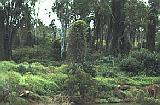 |
Tall towers of rubber vine Cryptostegia grandiflora cover trees along the Burdekin River, north Queensland.
Select the thumbnail image or highlighted name for a higher resolution image (39k). Photo: Kate O'Donnell
|
There are native animals that feed on the rubber vine, such as the Crow Butterfly, however, this has had no visible effect. Scientists have recently released a moth, whose caterpillar feeds on the leaves and a rust known as Maravalia which destroys the leaves. This has been effective in stripping the foliage off the vines and hopefully is a bit of a setback for rubber vine reproduction, however, it seems unlikely that this is the answer. CSIRO scientists have found that rubber vine is very fire sensitive and are using this method to control the plant where it grows on open plains. Along watercourses however, many of the native plants are fire sensitive and burning the vines may be destroying the very ecosystems we are trying to save. The answer to this problem is far from conclusive. In parks and areas close to towns, cutting and poisoning are effective, but who is going to cut and poison 3,500,000 ha of the stuff?
In the rainforest too, exotic vines are wreaking havoc. The Blue Thunbergia (Thunbergia grandiflora) from India was also introduced as a garden ornamental. It quickly escaped from cultivation and now smothers large areas of rainforest. This is a problem that has yet to be seriously addressed. The Blue Thunbergia is a declared weed in rainforest shires.
Of course, Thunbergia is not the only vine to wreak havoc of this nature. Add to the list a whole suite of ornamentals such as the Blue Ipomoea, Clitoria ternatea and Stinking Passionfruit. To "improve" native pastures for cattle grazing, a whole host of weedy vines have been introduced into our fragile ecosystems. These include Centrosema or "Centro", and the Siratro vine (Macroptilium). Not only do these species interfere with native ecosystems, but they interfere with other primary industries such as Sugar Cane. While busy improving the efficiency and cash flow of one industry, they are costing other industries and the environment big bucks.
Grasses
If the thought of all these vines choking our native bushland gets you, this next group, grasses, are just downright depressing. The problem seems just too big and insurmountable. Where do you start?
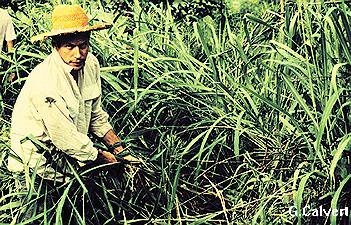 
Guinea Grass (Panicum maximum) is a tall, rank grass from the small nation of Guinea in Africa. Around Townsville, it is a particular problem close to rivers and on flood plains. Like the Para Grass, this is seen as being valuable feed for stock and the idea of having it declared a weed is at odds with the efforts of many people to spread it around the countryside. Apart from the fact that it grows so quickly it smothers any seedlings of native plants, is the fact that it produces high fuel loads for fires. Before the arrival of Europeans, riverside or riparian vegetation would have contained a large number of fire sensitive, semi-rainforest species and the occurrence of fires along riverbanks would have been rare. Guinea Grass provides the fuel to carry fire into the heart of such sensitive communities and this is a leading cause of deterioration of one of my favourite habitat types. The Guinea Grass itself is fire resistant and actually thrives. Fortunately, Guinea Grass doesn't respond well to being mowed but this is not an option on steep river banks.
Grader Grass (Themeda quadrivalvis) is a relative of our native Kangaroo Grass but is much taller. It was accidentally introduced as a contaminant of pasture grass seed and is declared a noxious weed in the Northern Territory but not in Queensland. This is despite the fact that it forms tall thickets covering large tracts of land, smothering native plants and greatly reducing diversity. It also invades crops such as Sugar cane and Lucerne and thereby causes financial losses as well as environmental. The fuel loads present here produce fires of an intensity that many native plants have not had to deal with before and therefore, thinning of native woodlands occur with each passing fire.
Grader Grass was an accidental introduction, unlike the Buffel Grass (Cenchrus ciliaris). This is one of the most widely sown pasture grasses in western Queensland and dominates over much of these areas. It is strong and aggressive and apparently has little nutritional value for native wildlife. I have had little success discussing the evils of Buffel Grass with graziers who assure me that it is non-invasive. But when you see areas from horizon to horizon covered with Buffel, you have to ask yourself what was there before hand. Like Grader Grass, Buffel increases the intensity of fires in areas where fires were always patchy and low in intensity. When it spreads into conservation areas, large amounts of taxpayers dollars must be spent in trying to reduce it.
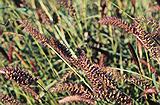 |
Flowering stems of buffel grass Cenchrus ciliovis at Wambiana Station near Charters Towers, Queensland.
Select the thumbnail image or highlighted name for a higher resolution image (58k). Photo: Greg Calvert
|
Some other grasses I don't want to dwell upon too much but I consider weeds are Fountain Grass (Pennisetum) and Liverseed Grass (Urochloa) both of which increase fire intensity and out-compete native grasses and seedlings.
Toxic Shrubs and Forbs
No discussion of weeds could be complete without mention of our foe, Lantana camara. Lantana originates from central America and comes in several different colour variations. It is quite an attractive plant and as you can imagine, it was introduced for ornamental purposes. It is still quite common to see Lantana for sale in Queensland nurseries because it is not declared here, although it is in NSW and the Northern Territory. According to the Department of Natural Resources, the reason it is not declared is because it is just too big a problem and is so widespread that nobody could afford to do any serious control measures on it. If you ask me, this is just admitting defeat and allowing the continued practice of selling and moving plants around, even though some northern areas have very little Lantana.
|
| "Lantana....is known to be allelopathic, which means that it produces chemicals specifically designed to retard the growth of other plant species around it." |
|
Lantana is by no means a purely Australian problem. It is a declared weed in many other countries, particularly in many Polynesian Islands and I understand the Island of Tonga is smothered by it. Lantana is spread far and wide by birds who seem to cherish the small black fruit. This weed forms vast, impenetrable thickets. The stems are prickly and difficult to walk through, the foliage is toxic to cattle, horses and humans and the thick, aggressive stands smother native bushland and effectively prevent any regeneration by native plants. It is known to be allelopathic, which means that it produces chemicals specifically designed to retard the growth of other plant species around it. It has been implicated in causing landslides and erosion because it reduces the area of cover by ground vegetation. Efforts are being made to try to control Lantana using biological control. To date, 23 different species of insect have been introduced to try to deal with this weed. These include fruit borers, flower borers and leaf miners. Few of the 23 insect species have established and although others do attack Lantana, they do not seem to make an appreciable dent on the huge Lantana populations. Further research continues.
A plant which is predicted to be just as bad as Lantana is the Bellyache Bush (Jatropha gossypifolia). This is from the Caribbean area and was introduced as an ornamental around the turn of the century. It is now spread throughout Queensland, Northern Territory and Western Australia. It is declared in the Northern Territory and, hopefully, will soon be declared in Queensland. The worst infestations I have seen are in the upper reaches of the Burdekin and around Charters Towers, although it apparently infests nearly one sixth of the Northern Territory. It has recently become established in Townsville and I hope that these small populations will be destroyed before they spread. Bellyache Bush forms dense thickets which exclude native plants and wildlife and is quite toxic. If you see this plant, kill it! Plants like this won't wait until they are declared a noxious weed before they act like one.
Bellyache Bush is often confused with another, taller plant called Castor Oil Bush which was, of course, introduced to extract oil from the seeds. It is declared noxious weed in the Northern Territory but not in Queensland because they don't believe it ever becomes a problem. It out-competes native species and is quite toxic to both humans and stock. We do, perhaps, need more uniform weed legislation or perhaps Queensland just needs to declare a lot more weeds.
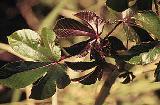 |
Top: Bellyache bush (Jatropha gossypifolia) at the base of Castle Hill, Townsville.
Bottom: Castor oil bush (Ricinus communis, is a familiar weed in many parts of Australia.
Select the thumbnail image or highlighted name for a higher resolution image (53k and 29k).
Photos: Greg Calvert
| 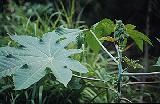 |
Another highly toxic and not-declared weed is Mother of Millions or Bryophyllum. This is a very popular ornamental plant as it takes no skill or watering to grow. Around old homesteads, rubbish dumps and in rocky hill slopes where fire cannot penetrate, Mother of Millions grows rampant. The toxins contained in these succulent cactus-like plants from Madagascar are similar to those from the dreaded Cane Toad. These may specifically attack heart muscles and can be fatal if ingested. Merely pulling the plant out is not enough and a bare rooted plant can survive months. If you burnt it you would do well not to inhale any of the fumes and this may also cause poisoning.
Parthenium Weed is a herb to about 2 metres tall with carrot like leaves and white flowers. It was accidentally introduced to Australia during World War 2 as a contaminant of machinery and equipment. Although it can smother fields and will grow just about anywhere, it is specifically targeted by many weed control agencies not because of its environmental problems, but because it causes severe dermatitis, hay fever and asthma in many people. It should be destroyed wherever it is found but already infests most of the Burdekin River catchment. In India; a country plagued by starvation and limited ability to produce enough food for their population, large areas of productive and arable land have had to be abandoned because of Parthenium. Biological control agents have recently been released in Australia.
Yellow Oleander (Thevetia peruviana) has also escaped from manicured gardens and gone feral. Although not present in large numbers yet, you could imagine the danger to fire fighters if they were to inhale fumes from this toxic weed during grass fires. Breathing smoke, eating any part of the plant or even stirring your tea with a twig can result in severe poisoning from this plant.
Chinee Apple
Also known as Chonky Apple, Indian Jujube or by its scientific name Zizyphus mauritiana, this thorny tree comes from Africa and southern Asia where it is a popular ornamental tree.
It was introduced into Queensland in the late 1800s/early 1900s by Chinese gold miners who joined the gold rush. They planted it around their shanty towns for the edible fruit which apparently make nice jam and pie filling. Now, Chinee Apple is the dominant vegetation of many of those old gold mining centres such as Charters Towers and occurs as far north as the Torres Strait. They are fast growing, fire and chain-saw resistant, form pure mono-cultured stands and can reproduce rapidly. A single tree can produce 8-10,000 seeds a year. These seeds can be spread by floods, cattle or by wildlife such as Agile Wallabies. Some people resist chopping down their Chinee Apples because they attract the Red-tailed Black Cockatoos which destroy, rather than disperse the seeds.
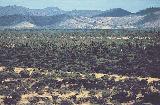 |
Woodland of Chinee apple, Zizyphus mauritiana with a large pocket of prickly acacia (Acacia nilotica), near Home Hill, Queensland.
Select the thumbnail image or highlighted name for a higher resolution image (49k). Photo: Greg Calvert
|
There are, however, far better trees for this purpose, such as the Sea Almond or any of the other Terminalia trees. Chinee Apple is declared P3 in Queensland, which means you have to reduce their numbers. This can be an extremely expensive process but it is a job that many people are now starting to confront in the North Queensland area. They currently occupy an area about 150,000 ha (15,000km2), although only a small percentage of that area is actually covered by this tree. It is perceivable that we could actually win the war against Chinee Apple and there is also research into biological control.
Tree Legumes
The next few weeds I would like to present are all tree legumes. Legumes do very well in these tropical environments and many have become significant weeds.
Leucaena, or Coffee Bush is a legume which originates from Central America and is known in some circles as "the miracle bush" because of the amount of weight that cattle gain when feeding on it. For this reason, there are now more than 50,000 ha of Queensland planted with this bush and graziers are being encouraged to grow more and more. Another half a million hectares are suggested for planting. Already, the alarm bells are ringing loud and clearly although many agriculturists and graziers seem not to hear. Leucaena is a declared noxious weed in 20 countries, which alone should have prevented its importation. It dumps huge amounts of seed which sit dormant in the soil, sometimes for decades. One study in Townsville found nearly 1,500 seeds in a single square metre. Even if you can chop and poison out the adult plants, you may still have to deal with the Leucaena menace for decades to come. After a fire or flood, the seeds germinate profusely and quickly reform the impenetrable thicket. These areas are often devoid of other plant or animal life.
|
| "Leucaena is a declared noxious weed in 20 countries, which alone should have prevented its importation.....One study....found nearly 1,500 seeds in a single square metre" |
|
In Australia, Leucaena has achieved weed-like status in Queensland, NSW, Northern Territory and Western Australia. A biological control agent in the form of a sap sucking psyllid bug accidentally found its way into Australia in the 1980s and did a lot of damage to Leucaena plantations. Instead of accepting the benefits of a control agent, a psyllid resistant cultivar named "Taramba" has been introduced. Not to be outdone, a colleague and I were cutting out Leucaena a few years ago when we discovered that pods had been drilled. CSIRO identified the organism as a Bruchid Beetle from Mexico that eats the seed. Immediately, everyone went into a panic except those who are interested in revegetation and conservation who thought it was a dream come true. The Bruchid beetle can destroy more than 80% of seeds but unfortunately it seems strongly seasonal and casual observations are that they only eat the seeds when on the tree, not on the ground. The beetle is only one of a host of weapons we must utilise to deal with Leucaena. Experiments are even being made using flamethrowers which, surprisingly, may be of great value in the war against this weed. A mysterious killer fungus may also be joining the fight. Unfortunately, due to its economic value, it will not be declared until the problem is too far out of hand to do anything about it.
From a potential problem now to a recognized disaster: The Prickly Acacia (Acacia nilotica). This spiny tree originates from Africa and was introduced to Australia as an ornamental and shade tree and as fodder for cattle. As usual, the plants escaped into the bush and this weed now covers a staggering 7 million ha of dry regions of Queensland. When visiting a site near Home Hill, I had aerial photographs that were ten years old and showed the area as a grassy, treeless plain. Now infestation by Prickly Acacia is extreme and had formed large forests. Not only does this plant suppress native vegetation, but it severely restricts the movement of wildlife and even cattle themselves. There are attempts to find a biological control for this weed but in the meantime, it is a declared weed which is treated with bulldozers and poison. Would you believe that there are numerous sheep farmers who oppose the eradication of this weed because of its value as shade for sheep. We still have a long way to go!
Another prickly Acacia species found around these parts is the plant known as Mimosa Bush (Acacia farnesiana). Although some people try to assure me that this is a native plant, it was originally introduced for the perfume industry because of its beautifully scented flowers and is also favoured as stock feed by graziers. By a slip of the pen, this plant is listed as P1 (totally prohibited). The Rural Lands Protection Board admit this is a mistake and state they have no intention of forcing anybody to deal with this plant. Although it isn't a problem in areas where cattle graze it, like all these sorts of things, they can form thickets in places like National Parks and wilderness areas where grazing doesn't occur.
The name Mimosa Bush is a little confusing. In the Northern Territory there is an extremely unpleasant plant called Giant Sensitive Weed or Mimosa pigra. Originally from central America, this prickly little fellow was growing quite happily in the Darwin Botanic Gardens for decades without any sign of spread, until a flood came along one day and spread its seed over a large area. This is arguably the worst weed in the Territory and covers 300 km2 of Kakadu and Arnhem Land. Feral Buffaloes once kept this plant under control, by stomping and crushing the weed underfoot. Now that the Buffalo have gone, the Mimosa is back with a vengeance. There are several avenues of attack, including chopping, poisoning, bulldozing and even napalm attacks. Lets hope that research into biological control yields some positive notes.
 
The final plant in this group of weedy tree legumes is the Jerusalem Thorn, also known by its scientific name: Parkinsonia aculeata. This prickly weed was introduced in the 1800s as a shade tree and is now a declared weed. Small thickets occur on the outskirts of Townsville but in inland Queensland, it forms impenetrable thickets along bore drains and around dams, preventing water access to stock and wildlife. Just another weed we can do without. Fortunately, several insects have been introduced which eat only Parkinsonia seed. One of these beetles is highly successful and is hoped to severely limit the amount of viable seed produced and thereby limit the rate of spread and re-infestation from treated areas.
Biological Control
I have, throughout this article, mentioned biological controls and the potential for weed eradication through its use. Many people are highly sceptical of the role of biological control and, to a degree, this attitude is well deserved.
Take for example the infamous Cane Toad, introduced as a biological control to eat the Gray Cane Beetle. Of course the Toad was never effective at controlling the beetle and instead became a terrible pest for which they are now looking for a biological control as well! A lot has changed between now and then. The Cane Toad was introduced by a consortium of Cane Farmers who went ahead with the project without any scientific evidence to support them and without any trials being undertaken. Now, a biological control cannot be released unless it has undergone at least 10 years of rigorous testing to ensure it will attack the desired plant and that plant alone. Since these rules were brought in, there hasn't been a single example of biological controls causing problems.
Prickly Pear
Apart from the Rabbit myxamatosis, Australia's biggest success with biological control has been with the Prickly Pear. This plant came to Australia on the first fleet, making it our oldest weed. Early settlers planted it for ornamental purposes and as hedges to keep cattle under control before barbed wire became affordable. As usual, the plant went berserk and soon covered vast areas of Queensland, forcing many graziers to abandon their properties. It was declared a weed in 1882 and by 1925, 24 million ha of Queensland were buried under a mat up to 2 metres deep of Prickly Pear. One can only imagine the environmental damage which must have resulted.
The government implemented all sorts of strategies and incentives for eradication, one of which involved spraying sulphuric acid and other horrible chemicals such as arsenic chloride from horseback. This killed some of the Prickly Pear and a lot of horses. There seemed to be absolutely no hope left when eggs of the Cactoblastis moth were introduced. All up, over 3,000 million moth eggs were distributed across Queensland to be spread onto the Prickly Pear plants. The cactus, which are 90% water, were chewed to pieces and the sea of cactus collapsed within a few years.
You still see a few Prickly Pear plants around. That is the nature of biological control. The parasite will not kill all of the host since it would, itself, die out. The moth and the cactus have now combined to keep the cactus at a permanently low level, far below the level at which it causes a problem.
|
| |
|
Still, an ounce of prevention is worth a ton of cure. If many of these weeds were not introduced in the first place, we would not have to deal with the problem. Everybody seems to have perfect hindsight, but what about the future? Have we learnt from our mistakes? Not at all. Here are some popular garden ornamentals which I believe are on the verge of making a takeover and which are still popularly sold in nurseries and dumped in the bush.
- African Tulip Tree: invading areas of the wet tropics world heritage rainforest
- Strawberry Tree: Sought after by many fruit eating birds which spread them into the bush. Already, many nursery owners have voluntarily stopped selling them.
- Singapore Daisy: A smothering blanket of death to our riparian forest. This should be declared immediately!
- Brazilian Pepper Tree: Spread by birds into local riparian communities where it rapidly invades.
- Agave Cactus: Already smothering numerous offshore islands south of the Whitsundays and spreading into the bush in many other places. A very dangerous plant which would certainly injure you severely you if you fell against one. Do we need to have plants like this in cultivation?
- Poinciana: Becoming a weed close to residential areas in Queensland and the Northern Territory.
- Javan Plum: An exotic and aggressive Syzygium that is popular here and a declared noxious weed in many other countries.
- Guava: Many people refuse to believe this, but Guava is a serious weed in Hawaii and South America. It has formed large impenetrable thickets in the wet tropics and I actively destroy them when possible.
|
|
So many of our new weeds are escaping from peoples gardens and becoming a weed. Of course, this is only a fraction of these problem plants and I'm sure you could think of more. But many of our weeds are being deliberately introduced by government agencies for native pasture improvement. These plants are specifically selected for their ability to handle extreme conditions, spread rapidly, compete with native plants and endure grazing. These same features are the characteristic traits of many weeds. Improved pasture researchers spend considerable time overseas searching for new and exotic weeds that can be introduced to Australia, and unlike biological control agents, there is no 10 year testing limit to see if they can do ecological damage. The only criteria that needs to be met is that those plants be palatable to grazing stock, as if these plants could somehow be convinced to stay behind the barbed wire fences of cattle properties.
Just one example is the legume Stylosanthes, or simply Stylos as it is commonly known. Over the last 30 years, more than 90,000 ha have been sown with Stylos, to allow cattle to continue grazing areas which have previously been stripped of native grasses by poor property management. There is increasing amounts of information to suggest that Stylos causes soil acidification and competes with native vegetation. The result is widespread dieback of eucalypts. More Stylos, Leucaena, Macroptilium and exotic grasses are being exported all the time and it really is time they stopped. The current situation just exaggerates the continuing process of land degradation that future generations will certainly not be thanking us for.
To conclude this article, I want to stress that any plant has the potential to become a weed if moved from its natural habitat and planted somewhere of a suitable climate that is free of pests and diseases where it is able to reproduce. A simple concept one might imagine but one which seems to escape some groups and organisations. I was horrified recently when I read an article on the World Seed Program. The objectives of this group are to help combat environmental degradation through the distribution of trees. A noble program one may think, until you see the list of trees being distributed worldwide: Leucaena, Acacia nilotica, Mesquite (declared in Queensland), our native Acacia A.auriculiformis (topping the list on weeds of Florida) and Albizia lebbeck , which is a severe weed in Florida and is posing an environmental threat on Townsville's own Castle Hill. Their advertisement was right; they certainly are a group involved with environmental degradation!
Thank you very much for perusing my thoughts and opinions on environmental weeds and I hope I may have stimulated some thought about the burden we have placed upon our environment. If ever there was a time when the Society for Growing Australian Plants should be encouraging people to give up growing exotic weeds and grow natives, it is now.
Greg Calvert is a postgraduate student at James Cook University undertaking his studies for a doctorate in botany. His many research interests include fire and grazing impacts on native plants and animals, and traditional plant knowledge of Aborigines in North Queensland. Greg is also an active member of Landcare and spends most of his spare time either in the Landcare nursery or waging war against a wide diversity of introduced weeds. Zoology also occupies much of his time, conducting fauna surveys and removing problem snakes from houses in the Townsville area. Greg has been an active member of the Society for Growing Australian Plants since 1989 and has written numerous articles for the Queensland branch newsletter.

[Front Page] [Features] [Departments] [Society Home] [Subscribe]
Australian Plants online - December 1999
Association of Societies for Growing Australian Plants
|